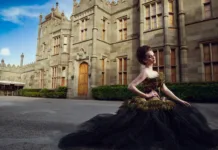Last Updated on February 26, 2025 by Used House Of Vintage
Vintage clothes are a piece of history that has sentimental attachment. But, other than this, they are valuable pieces of fashion too. Adding these clothes to your wardrobe is just as fantastic as filling your home with treasure. These garments are just a vibe from getting the retrofits to a relaxed bohemian look. Moreover, a lot of present clothing trends are influenced by vintage styles. However, this can create an issue that the dress you absolutely thought was made in the seventies might be from any thrift store or retailer.
Have you ever picked an outfit at a thrift store and wondered if it was genuinely vintage or not? Furthermore, you all are curious to know how people identify a vintage garment decade or era by just looking at the style? Well, these clothes were explicitly recognized by their fabric, tailoring, and label. So, spotting and identifying these things can indeed help you obtain a perfect vintage closet. Check out the other sections of this article to know the ways that will help you to spot authentic vintage clothing quickly. Read these couple of hints carefully because they can clue you into the real world of this clothing.
How do you know it’s vintage?
It is the juicy question of the day. Like, how can you identify vintage clothing? This question makes it different from your regular clothes. There are a lot of details to pay attention to while investing in these clothes. So, let’s break down the main things and little characteristics to determine if your purchase is vintage or not.
-
Check the tag
TAG can provide you with a wide range of information. It is like the first clue in the whole story. It can be beneficial from knowing the fabric content to recognizing the decade or era of your vintage cloth. Moreover, brand tags vary by decade.
a. Handmade
Most of you know that handmade clothing did not contain any tags and labels in early times. Commonly, the items made between the 1950s and 1970s have this identity. It can help you spot the vintage clothes that were handcrafted by themselves.
b. Care tag
In 1971, the Federal Trade Commission made it mandatory to include a how-to-wash tag or care tag in every clothing piece. Check out the vintage clothes labels to know the manufacturing year. Furthermore, most of the time, people get irritated and feel itchy because of tags, and they often cut them out. So, do the research mindfully. Moreover, if your garment is missing care or instructional tag, there’s a good chance to pinpoint that your vintage cloth was made before 1971.
c. Fiber content
Nowadays, with the digitalization of everything, online shopping is rocking in its world. Well, you don’t have to search to know the fiber content of each piece. Every clothing piece, from western to ethnic, from women’s to men’s wear, from adults to kids, has its specifications readily available on the internet. But, how do people in earlier times know the fiber content of the garment they are buying? Yeah, you guessed it right! As mentioned earlier, tags are the most significant hint in vintage clothing.
Fiber content tags have been required in vintage clothes since 1960, so if you own a garment that does not contain this tag, it might be older than 1960. Talking deeply about the vintage clothes of the 1950s, which consist of the fiber tags, but the information of material percentage is missing. For instance, the label might just show “cotton” with no percentage with it.
d. Size
Comparing the size is the best and quick way to spot a vintage item. As you all know, the thumb rule of standardizing sizing is more prevalent in modern pieces. Basically, this sizing rule of vintage clothing was started in early 1958. So, there are equal chances that a cloth piece without size is listed likely to be older than 1958. Additionally, you can quickly identify the size from the cloth label
e. Font and style number typography
Specific eras come with different and unique font tags. It might confuse beginners to notice that vintage clothes have different typography. It requires practice. If you have any family members or you grew up in the ’70s or ’80s, it can be easy to differentiate the vintage clothes based on label font. Moreover, most of the same brands have been manufacturing the clothes for decades. For instance, If you just compare the modern design label with the vintage clothing label, you can easily catch the difference. And by this way, you have just found some vintage clothes, my friend!
Read this article : Retro Vs. vintage fashion – what is vintage clothing?
2. Check the zipper and buttons
Undoubtedly, it is true that many things have changed with time. Everything has changed from the style of zips to the type of buttons. You can ask the question about vintage clothes that do the item have a zipper? If so, what is the zipping style, and what is the material used? So, let’s look into it more informatively to know vintage clothes in a better way.
a. Metal zipper
If your vintage garment does not contain any tag or you cannot spot the genuine vintage cloth, then the zip can still help you in this task. If the zips are of metal material, your piece is more likely to belong to 1963 or earlier. Furthermore, with time the material changed to plastic, and by 1968, most of the clothes contained plastic or woven zip. This zip study makes it easier for everyone to know the manufacturing year or era of the vintage garment.
b. Zipper placement
Zips are the gamechanger in the style of vintage clothing. Firstly, size zip placement became the norm between the ‘30s and ‘40s. Most dominantly, only two zipper placement styles were used at early times. It can be either on the side or down the middle of the back. Side zip placement rocked the trends in its era. But in the ‘50s, ‘60s, and ‘70s, the vogue of middle back zippers became popular.
c. Buttons
Buttons can be categorized into three major types of plastic, including bakelite, lucite, or modern. Bakelite buttons are mostly colored and were primarily used in vintage garments of the 1930s and ‘40s. After this era, lucite buttons came in use and rocked their demand in the 1950s. They are mostly clear and transparent pieces of plastic. Furthermore, modern plastic buttons were adopted in the 1960s and are presently in use. However, modern plastic buttons somehow show a cheaper look than bakelite and lucite buttons.
3. Look at the style
As of now, you can spot any vintage cloth by looking at its tag and the zipper placement and buttons. But do you think anyone can identify a vintage piece by just looking at the style? Yes, it is true. And of course, if the answer is yes, it would be the best and easiest way to recall the memories of vintage clothes of history. As you all know, these clothes have different sleeves, lining, and overall styles with specific eras. Below mentioned points will help you figure out a particular decade’s designs by studying their style.
a. Sleeves
The first thing to look at in sleeves is their tailoring, whether oversized or arm fit. Before and till the 1960s, sleeves were tailored according to one’s arms fit. But sleeve design has changed a lot over the years. During the 1970s, the trend of bishop and ball sleeves became the bestseller. These styles of sleeves were commonly a part of the ‘70s Edward style. After this, in the 1980s, the fashion of batwing, dolman, and puffy shoulder sleeves were prominent and are pretty iconic. That’s how you can classify any vintage cloth by just checking over the sleeves of any outfit.
b. Lining
Do vintage clothes contain lining? Are you curious to know the same? Generally, any piece of clothing made before the 1970s does not carry the linings because they usually have slips that act as liners. Moreover, polyester was very famous in the ‘70s. So, if you have any cloth that does not have linings and is of polyester fabric, then bet on your vintage find to be from the ‘70s. But with the span of time, things changed, and linings smashed the popularity. Linings were introduced in the 1980s as people became body-conscious and opted for fitted clothes.
c. Style
If you are crazy about vintage clothes, you should definitely know what styles are most iconic for what era. You can notice the shape of the garment. For instance, what type of sleeves does it have? Does the top have shoulder pads, or what kind of waist does it have? And the list is endless. Every decade had its signature style that became the most popular or chart-topping. In the ‘50s, women’s fashion got the attention of the hourglass silhouette. Hats, gloves, and girdles were like the necessary equipment. Tiny waist dresses and billowing skirts were trendy.
In the 1960s, fashion changed, leading to a new inventive world of style. Boxy cuts, high necklines, bright colors, large buttons, go-go boots, and mini skirts stole the heart of people. By the late 1960s, bell-bottoms, paisley, and psychedelic colors to the masses. The next decade of 70s rock in their trend and is considered the disco era. Moreover, platform shoes, hot pants, tight halter tops, and sequin-adored attire made the ‘70s fashion superhit.
In the 1980s, layered garments, loads of jewelry, and colorful makeup inspired the people. All enjoyed converse chucks, parachute pants, and Wayfarer sunglasses. There were no differences in the styling sense of women and men.
Conclusion
On the whole, identifying vintage clothing is not that laborious. There are specific ways mentioned above by which you can easily do the same task—hoping that this guide will help you on your journey to an entire vintage closet! Once you start paying attention to these details, you will never fail in recognizing the real or fake vintage. By using these tips, you can surely hunt up some incredible pieces of history. Happy hunting and shopping of vintage!




